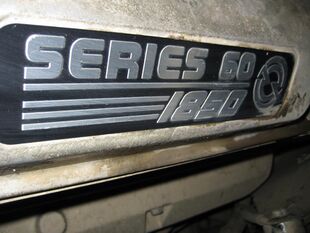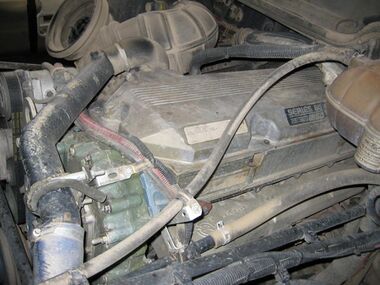Engineering:Detroit Diesel 60
| Series 60 | |
|---|---|
 | |
| Overview | |
| Manufacturer | Detroit Diesel |
| Production | 1987–2011 |
| Layout | |
| Configuration | Inline-6 |
| Displacement | 677, 775, 854 cu in (11.1, 12.7, 14.0 L) |
| Cylinder bore | 5.12 in (130 mm) (11.1L)[1] 5.24 in (133 mm) |
| Piston stroke | 5.47 in (139 mm) (11.1L)[1] 6.3 in (160 mm) 6.62 in (168 mm) |
| Valvetrain | OHC[1] |
| Compression ratio | 15.0:1 (11.1L)[1], 16.0:1, 16.5:1 |
| Combustion | |
| Turbocharger | Wastegated |
| Fuel system | Fuel injection |
| Fuel type | Diesel |
| Cooling system | Water-cooled |
| Output | |
| Power output | 330–605 hp (246–451 kW) at 1800–2100 rpm (11.1 L)[1] |
| Torque output | 1,150–2,050 lb⋅ft (1,559–2,779 N⋅m) at 1200 rpm (11.1 L)[1] |
| Dimensions | |
| Length | 57 in (1,400 mm) (11.1L)[1] |
| Width | 34 in (860 mm) (11.1L)[1] |
| Height | 50 in (1,300 mm) (11.1L)[1] |
| Dry weight | 2,550 lb (1,157 kg) (11.1 L)[1] |
| Emissions | |
| Emissions control technology | Diesel particulate filter |
| Chronology | |
| Predecessor | Series 71 |
| Successor | DD15 |
The Detroit Diesel Series 60 is an inline-six 4 stroke diesel engine produced since 1987. At that time, it differed from most on-highway engines by using an overhead camshaft and "drive by wire" electronic control. In 1993, it was popular on many USA buses in the 11.1 L (677 cu in) displacement.
History
When it was introduced in 1987, the Series 60 was the first heavy-duty diesel engine with fully integrated electronic controls.[2] Detroit Diesel prescribed overhaul intervals of 500,000 miles (800,000 km), then raised that to 750,000 miles (1,210,000 km) after more experience was gained with the new engine.[3]
In 1993, the 11.1 L (677 cu in) version was rated at 350 bhp (261 kW) (but would produce 15 more if the cruise control was engaged).
12.7L
The Series 60 was also available in 12.7 L (775 cu in) at the time, which was created by a longer stroke of 6.3 in (160 mm).[4] Both engine sizes were also used in truck and tractor-trailer applications.
In 1998, the 11.1-liter Detroit Diesel Series 60 was discontinued.[5] Once the 11.1-liter Series 60 was discontinued, the 12.7-liter Detroit Diesel Series 60 became the motorcoach application. Starting in the late 1990s, Neoplan made the Series 60 as an available engine for their high-floor and low-floor articulated buses - the AN460A and AN460LF. Detroit Diesel began making Series 60 marine engines in 1999, with wider availability starting in 2000.[6]
14.0L
In 2001 the bore and stroke increased and the engine displacement rose to 14 L (854 cu in), with an increase in power output to 575 hp (429 kW) and a torque increase to 1,850 lb⋅ft (2,508 N⋅m).
In 2004 the 14-Liter engine became the dominant platform in Freightliner over the road sleeper trucks and changed the ECM to a DDEC V. The 12.7L engine was favored in buses for its better fuel consumption.[5]
In 2007 the 12.7-liter Detroit Diesel Series 60 was discontinued. Once the 12.7-liter Series 60 was discontinued, the 14-liter Series 60 replaced it. By 2008, Detroit Diesel had produced one million Series 60 engines.[7]
In 2007 - 2010 (2008 -2011 trucks), the Detroit Diesel 14L engine was modified to meet new emissions standards and went to a dual ECM configuration (DDEC VI). This engine ran higher compression, higher injector pressure and a DPF exhaust filter. The block and crank remained the same as the older 2004-2006 engine models.
In 2011 the series 60 engine was discontinued and replaced by the DD15 engine.
Specifications
| Displacement | Bore | Stroke | CR | Torque | Power | Dimensions (L×W×H) |
Weight |
|---|---|---|---|---|---|---|---|
| 677 cu in (11.1 l)[1] | 5.12 in (130 mm) | 5.47 in 139 mm |
15.0:1 | 1,150–1,350 lb⋅ft (1,559–1,830 N⋅m) @ 1200 rpm |
330–365 hp (246–272 kW) @ 1800–2100 rpm |
57 in × 34 in × 50 in (1,450 mm × 860 mm × 1,270 mm) | 2,550 lb (1,157 kg) |
| 778 cu in (12.7 L)[4] | 6.3 in (160 mm) | 16.5:1 | 1,350–1,550 lb⋅ft (1,830–2,102 N⋅m) @ 1200 rpm |
330–430 hp (246–321 kW) @ 2100 rpm |
2,640 lb (1,197 kg) | ||
| 854 cu in (14.0 L)[4] | 5.24 in (133 mm) | 6.62 in (168 mm) | 16.0:1 | 1,550–1,650 lb⋅ft (2,102–2,237 N⋅m) @ 1200 rpm |
435–550 hp (324–410 kW) @ 2100 rpm |
Electronic Control
The most popular on-highway Detroit Diesel engine was the 12.7-liter, and on-highway engines are electronically-controlled by the proprietary Detroit Diesel Electronic Control (DDEC) system. The DDEC system was the first commercial use of a fully electronic control on a highway engine, and multiple years would pass before other manufacturers followed. The functions available in the DDEC system include engine diagnostic functions, shutdown timers, progressive-shift functions, fault-history, speed limiting, automatic-stall preventing, and cruise control functions; the cruise control function is popular with fleet operators due to the fuel-saving nature of this function. The DDEC system permitted the owner to download engine management reports, including a record of the use of the engine. The system was able to provide records of truck overspeeding, excessive idle time, hard braking, and other parameters, thereby assisting owners in increasing productivity, reducing engine abuse, and decreasing fuel consumption.
Larger fleets purchased their own copies of the software, while smaller owner operators were able to have their computer datasets downloaded by the dealer servicing their engine. The DDEC system allowed dealers and owners to troubleshoot problems with their engines, permitted changes to horsepower settings, and in some cases, alternative programs were able to be loaded into the computer.
The DDEC system is easy to operate, and diagnostic functions are displayed to the driver. Typically, there are two indicator lights, one in yellow and one in red. The red indicator represents a significant-engine fault, and in most cases, the engine shuts down to protect the engine from damage. The yellow light represents a minor fault, and is a cautionary function to alert the operator to a fault that might not be dangerous, or represent immediate damage to the engine. The operator is able to gain basic diagnostic functions via these two lights. Accompanying the two lights there generally is a switch; when pressed in specific circumstances, the red and yellow lights will flash in a specific order and the operator is able to calculate a fault code, and know the specific problem with the engine.
DDEC I

Initially the engine was controlled by the DDEC I System, which was shortly after replaced by the DDEC II system which would last up to 1992.
The DDEC I system was a two-box system. It had an Electronic control module (ECM) in the cab, and an Electronic Driver Module (EDM) on the engine to operate the injectors.[5]
DDEC II
The DDEC II ECM was a single box mounted on the engine.[5]
The DDEC II Engine was available in ratings between 365 hp (272 kW) and 500 hp (373 kW) of torque. The engine proved extremely popular with fleet operators, and built a strong reputation for reliability and longevity. It was also available in a popular "cruise power" configuration, whilst encouraging the operator to engage the cruise control function. During the normal use of the engine, 430 hp (321 kW) would be available, and whilst the cruise control was engaged, the horsepower rating would increase to 470 hp (350 kW), as/since/because the engine was the most economical whilst the cruise control was engaged.
DDEC III
In 1992, the DDEC III system was introduced, and is available in horsepower ratings up to 470 hp (350 kW) due to revised camshaft timing and other improvements. Again, a "cruise power" option is available, and the standard rating was 430 hp (321 kW), and whilst the cruise control is engaged, the horsepower rating increased to 470 hp (350 kW), encouraging operators to take advantage of reduced-fuel consumption.
The DDEC III system also introduced dual-voltage (12V/24V) ECM units. Previous DDEC ECM units are 12-volt only. The dual-voltage ECMs ease installation into 24-volt marine, industrial, and non-USA trucks. The use of Battery Charge-Equalizers (Vanner) is not required as/since/because the ECM can connect directly to the 24-volt batteries.
The DDEC III ECM is thinner than the DDEC II ECM, with wiring connectors at both ends. The front-end has two five-pin connectors for the injectors, and a thirty-pin connector for the engine-sensors. The rear-end has a five-pin Power Connector, six-pin Communications Connector, and a thirty-pin Vehicle-Interface Harness-Connector.
DDEC IV
1997 brought the introduction of the DDEC IV engine control module, and further improvements in the design of the engine, notably a wastegated turbocharger and engine management improvements provided increased horsepower ratings up to 500 hp (373 kW), and increased torque outputs to 1,650 lb⋅ft (2,237 N⋅m).
Competing power plants
- Caterpillar Inc C11, C12
- Cummins
- Cummins ISM
References
- ↑ 1.00 1.01 1.02 1.03 1.04 1.05 1.06 1.07 1.08 1.09 1.10 "Detroit Diesel Series 60: 300-365 bhp specs". Detroit Diesel. 1996. http://www.detroitdiesel.com:80/products/series60/300specs.html. Retrieved 18 July 2018.
- ↑ "Detroit Diesel Series 60". Detroit Diesel. 1996. Archived from the original on 31 January 1998. https://web.archive.org/web/19980131142941/http://www.detroitdiesel.com/products/series60/series60.html. Retrieved 18 July 2018.
- ↑ Senefsky, Bill (28 September 2007). "Detroit Diesel Series 60 Engines - The Saga of Detroit Diesel". Diesel Power Magazine. http://www.trucktrend.com/news/0709dp-detroit-diesel-engine-history/. Retrieved 18 July 2018.
- ↑ 4.0 4.1 4.2 "Series 60 Coach Power". Detroit Diesel. 2004. Archived from the original on 23 October 2004. https://web.archive.org/web/20041023072627/http://www.detroitdiesel.com/Public/specs/3SA438.pdf. Retrieved 18 July 2018.
- ↑ 5.0 5.1 5.2 5.3 "Engine spotlight: Detroit Diesel Series 60". Highway and Heavy Parts. https://highwayandheavyparts.com/n-12777-detroit-diesel-series-60-engine-spotlight.html. Retrieved 18 July 2018.
- ↑ Henderson, Keith (16 August 2000). "First Look: Detroit Diesel Series 60". boats. https://www.boats.com/first-look-detroit-diesel-series-60/. Retrieved 18 July 2018.
- ↑ "The Legendary Series 60". Detroit Diesel. 2009. Archived from the original on 21 March 2009. https://web.archive.org/web/20090321080857/http://www.detroitdiesel.com/engines/series60/. Retrieved 18 July 2018.
- ↑ "Series 60 - Specs". Detroit Diesel. 2004. Archived from the original on 7 February 2005. https://web.archive.org/web/20050207090232/http://www.detroitdiesel.com/products/Series_60/specs/index.asp. Retrieved 18 July 2018.
- Detroit Diesel Series 50&60 for Petroleum Applications. Detroit Diesel. 2003. p. (Sales brochure).
External links
- "2007 Series 60 Technical Data". Detroit Diesel. 21 March 2006. Archived from the original on 21 February 2007. https://web.archive.org/web/20070221052539/http://www.detroitdiesel.com/pdf/Engines/2007_S60_specs.pdf. Retrieved 18 July 2018.
- "Detroit Diesel Series 60 Engine Owners Manual". Fitzgerald Glider Kits. https://www.fitzgeraldgliderkits.com/wp-content/uploads/2016/09/owners-manual.pdf. Retrieved 18 July 2018.
- "General Information for 60 Series Detroit Diesel Engines". Engine Builder. 24 September 2009. http://www.enginebuildermag.com/2009/09/general-information-for-60-series-detroit-diesel-engines/. Retrieved 18 July 2018.

